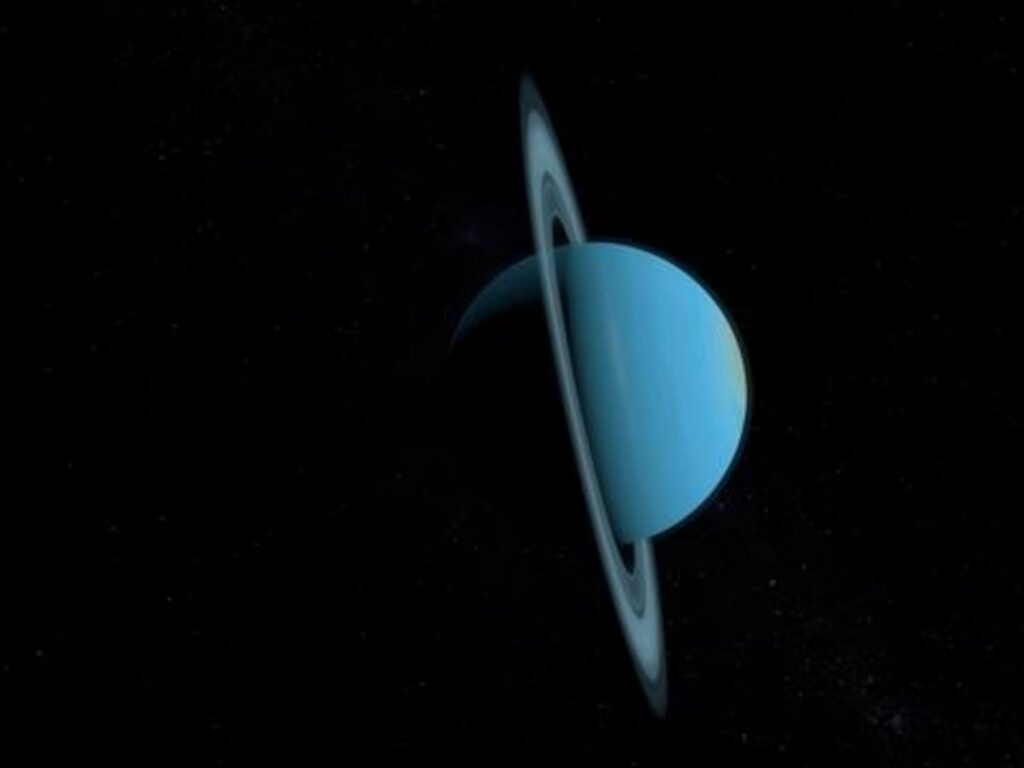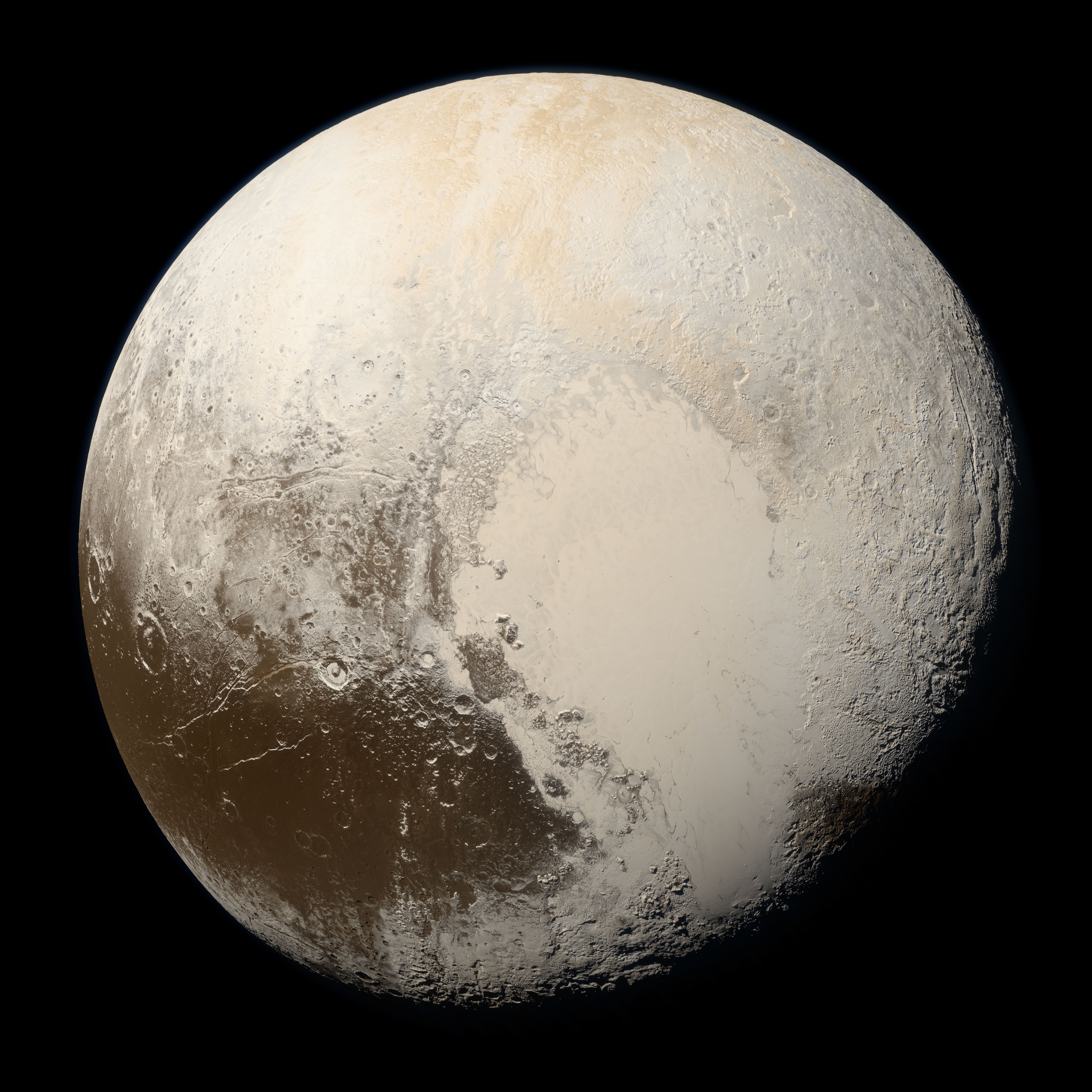Table of Contents
A Revolutionary Discovery in Astronomy
For centuries, celestial observations were limited to what the naked eye could perceive, with planets like Mercury, Venus, Mars, Jupiter, and Saturn being the only known worlds. The discovery of Uranus in 1781 by William Herschel marked a turning point, proving that the solar system extended far beyond what was previously imagined. Initially cataloged as a star in various historical records, its slow movement defied expectations. Herschel’s telescope provided the breakthrough needed to distinguish it as a planet, challenging traditional astronomy. This newfound world not only reshaped planetary studies but also fueled the search for more celestial bodies, ultimately leading to the discovery of Neptune nearly 65 years later.
The naming of Uranus deviated from established norms, as previous planets were named after Roman gods. Herschel initially proposed naming it “Georgium Sidus” (George’s Star) in honor of King George III, which gained favor in England but was rejected by the broader scientific community. Instead, the astronomer Johann Bode suggested a name rooted in mythology, honoring the Greek god of the sky. This choice aligned with astronomical traditions yet stood apart as the only major planet named after a Greek deity. The discovery, while initially controversial, ultimately cemented the importance of systematic celestial observations and paved the way for future planetary findings.
A Planet That Rolls Instead of Spins
Unlike the rest of the solar system’s planets, which rotate more conventionally, one world behaves more like a rolling ball in space. With an extreme 98-degree axial tilt, Uranus defies expectations by rotating almost perpendicular to its orbit. This unique tilt likely resulted from a colossal impact with an Earth-sized object during its early formation, permanently altering its orientation. As a result, the planet’s poles take turns facing the Sun directly, leading to some of the most extreme seasonal changes known. A single pole can be bathed in sunlight for 42 years before plunging into 42 years of uninterrupted darkness, an occurrence unseen on any other major planet.
Because of this sideways rotation, Uranus experiences weather patterns unlike those of its planetary neighbors. The shift between decades-long daylight and darkness disrupts atmospheric circulation, creating unpredictable wind patterns and storms. Scientists have studied how this unusual orientation affects the movement of gases within the planet’s atmosphere, but many questions remain unanswered. The extreme tilt also influences the behavior of the planet’s magnetosphere, which wobbles dramatically as it rotates. This dynamic environment continues to intrigue astronomers, making the ice giant an important subject in understanding the impact of planetary collisions on long-term rotational stability.
A Chillingly Unique Atmosphere
The striking pale blue hue of this distant world is the result of methane gas, which makes up a small but significant portion of its atmosphere. Methane absorbs red light from the Sun and reflects blue, giving the planet its distinct coloration. However, beneath this calm exterior lies a turbulent atmosphere, filled with dynamic cloud formations and high-altitude haze. The upper layers contain trace amounts of hydrocarbons, such as ethane and acetylene, formed through chemical reactions driven by ultraviolet radiation. Despite its serene appearance from afar, the planet’s atmosphere is anything but still, with winds reaching speeds of up to 560 miles per hour (900 km/h).
Beneath the visible cloud layers, Uranus’ composition sets it apart from its larger gas giant neighbors. Unlike Jupiter and Saturn, which are dominated by dense metallic hydrogen layers, this ice giant consists primarily of water, ammonia, and methane ices surrounding a small rocky core. Scientists believe that these icy materials were abundant during the planet’s formation, leading to its distinct internal structure. Despite its mass, the planet emits very little heat, making it the coldest in the solar system. This lack of internal warmth remains a mystery, as planetary models suggest it should retain more of its original formation heat.
An Icy Beginning in the Outer Solar System
The birth of this distant world began approximately 4.5 billion years ago in the cold, outer reaches of the solar system. Unlike Jupiter and Saturn, which formed in warmer regions and rapidly collected thick gaseous envelopes, Uranus developed in a zone rich in icy materials. This environment allowed the planet to accumulate a core made primarily of rock and ice, surrounded by a relatively thin atmosphere. The lower temperatures of its formation zone likely influenced the planet’s composition, leading to an internal structure dominated by water, methane, and ammonia ices. These conditions set it apart from the larger gas giants, classifying it instead as an ice giant.
One of the most puzzling aspects of Uranus is its extreme lack of internal heat, making it the coldest major planet in the solar system. Some scientists propose that the violent impact responsible for its sideways tilt may have also stripped away much of its primordial heat, preventing it from radiating warmth like its planetary neighbors. This loss of heat remains a significant mystery, as even Neptune, which formed under similar conditions, emits more energy than it receives from the Sun. Understanding why this ice giant failed to retain heat could provide insight into planetary formation and evolution beyond the solar system.
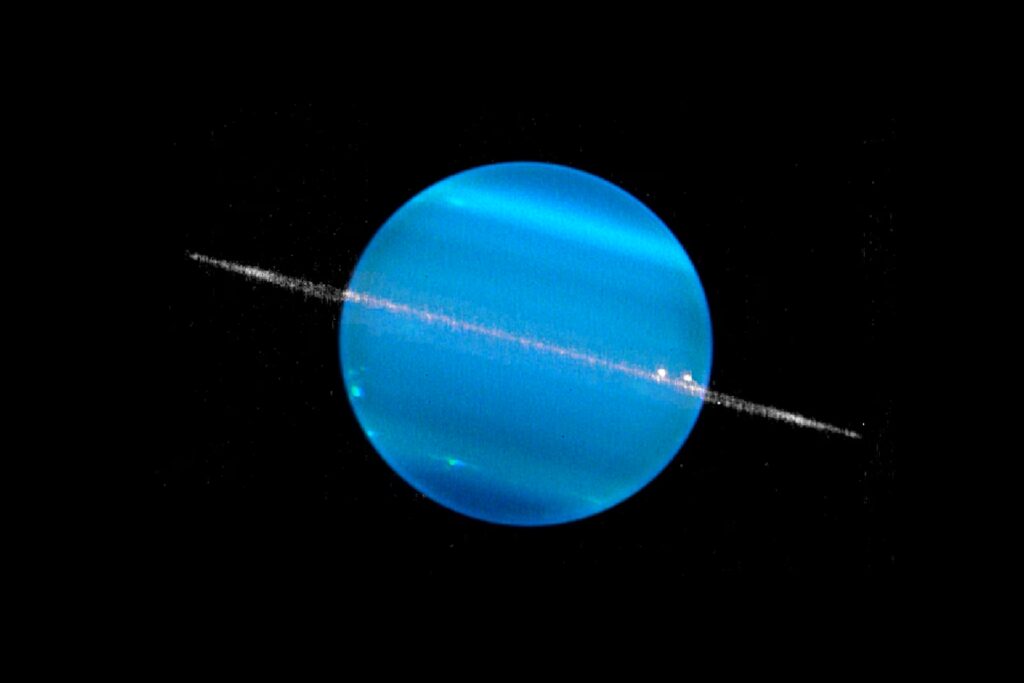
A Chaotic and Misaligned Magnetic Field
Most planets have magnetic fields that align closely with their rotational axes, but this distant ice giant defies that pattern. Its magnetic field is tilted at an extreme 59-degree angle, meaning it does not pass symmetrically through the planet’s center. Instead, it is offset, creating an uneven distribution of magnetic forces across the planet’s surface. As the planet spins, this misalignment causes the magnetosphere to lurch unpredictably, opening and closing to solar wind in ways unseen on other planets. The Voyager 2 flyby in 1986 provided the first glimpse of this bizarre structure, revealing a complex system that shifts dramatically with each rotation.
Because of this unique orientation, Uranus experiences unpredictable space weather that differs from the steady magnetic shielding seen on Earth. The constantly shifting magnetosphere means that charged particles from the Sun interact with the planet in irregular bursts, affecting the formation of auroras. Unlike Earth’s polar auroras, which occur near magnetic poles, auroras on this ice giant can appear at unusual locations, shifting unpredictably. Scientists suspect that the planet’s unusual magnetic field may be the result of deep-seated flows within its icy interior. Future missions aim to study this chaotic system further, offering new insights into magnetic fields across the universe.
A Hidden Ring System in the Outer Solar System
Unlike the bright, easily visible rings of Saturn, this distant ice giant’s ring system remains faint and elusive. The 13 known rings are composed primarily of dark, icy debris, likely remnants of ancient moons that were shattered by collisions. Their discovery in 1977 was unexpected—astronomers detected them when the planet briefly blocked the light of a distant star in a pattern indicating multiple thin rings. Unlike the wide, reflective rings of Saturn, these are narrow and nearly invisible in most wavelengths of light. Scientists suspect that their extreme darkness is due to radiation-altered organic compounds, which prevent them from reflecting much sunlight.
The structure and formation of the rings remain a mystery, but observations suggest they are relatively young, possibly only a few hundred million years old. Unlike the vast, complex systems of Jupiter or Saturn, the rings around Uranus are confined and sharply defined, possibly shaped by small shepherd moons. Some of the outer rings are more diffuse, hinting at interactions with unseen objects or past collisions. Because of their low reflectivity, studying them requires advanced infrared and radio telescopes. Future missions aim to investigate their composition further, helping scientists understand how ring systems evolve across the solar system.
A Moon System Unlike Any Other
The 27 known moons orbiting this distant ice giant make up one of the most diverse and intriguing satellite systems in the solar system. Unlike other planets, whose moons are often named after mythological deities, these moons draw inspiration from the literary works of William Shakespeare and Alexander Pope. Titania and Oberon, the two largest, are composed primarily of ice and rock, suggesting a history of geologic activity. Some of the smaller moons, such as Ariel and Umbriel, show signs of past surface changes, hinting at internal processes that may have shaped their current forms. Their compositions suggest they formed from the same material as the planet itself.
Among these celestial bodies, Uranus’ moon Miranda stands out as one of the most peculiar objects in the solar system. Its surface features towering cliffs, deep canyons, and jumbled terrain that appears pieced together from separate worlds. Scientists theorize that Miranda may have undergone multiple violent collisions, shattering and reforming in a chaotic cycle. Some of its cliffs, such as Verona Rupes, are believed to be the tallest known in the solar system, stretching over 12 miles high. The unique geological diversity of its moons suggests a dynamic history, making this planetary system a key target for future exploration.
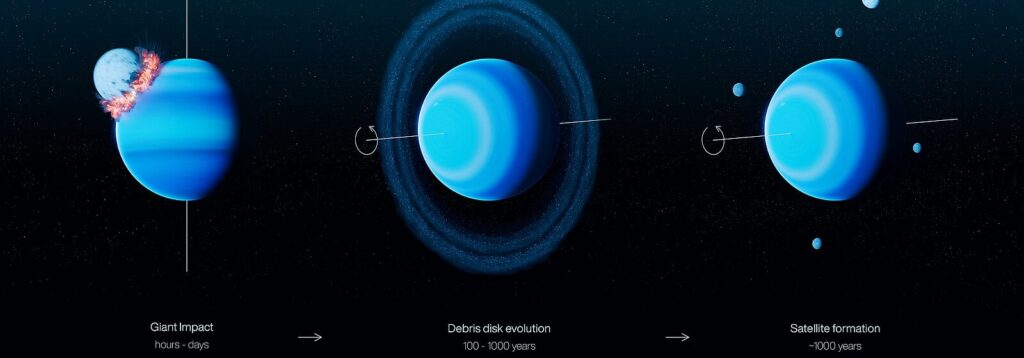
A Brief but Historic Encounter
In 1986, NASA’s Voyager 2 became the first and only spacecraft to visit this distant ice giant, capturing groundbreaking data that reshaped scientific understanding. The flyby confirmed the presence of dark, thin rings encircling the planet and provided the first close-up images of its moons. It also revealed a surprisingly featureless atmosphere, appearing as a smooth, pale blue sphere with only subtle cloud formations. Voyager 2 measured the planet’s extreme cold, recording temperatures lower than any other planet in the solar system. Despite these achievements, the mission was brief, with the spacecraft passing by at high speed, limiting the amount of detailed data scientists could collect.
Even with the limited time spent studying Uranus, Voyager 2 uncovered unexpected discoveries, such as the planet’s highly tilted and offset magnetic field, which defies conventional planetary models. The spacecraft also captured images of its unusual moons, including Miranda, which displayed some of the most bizarre terrain in the solar system. However, many mysteries remain, as the flyby provided only a snapshot of a complex world. Scientists continue to push for a follow-up mission, possibly a dedicated orbiter, to explore the planet in greater depth. Future spacecraft could study its dynamic atmosphere, ring system, and moons to answer lingering questions from Voyager’s historic encounter.
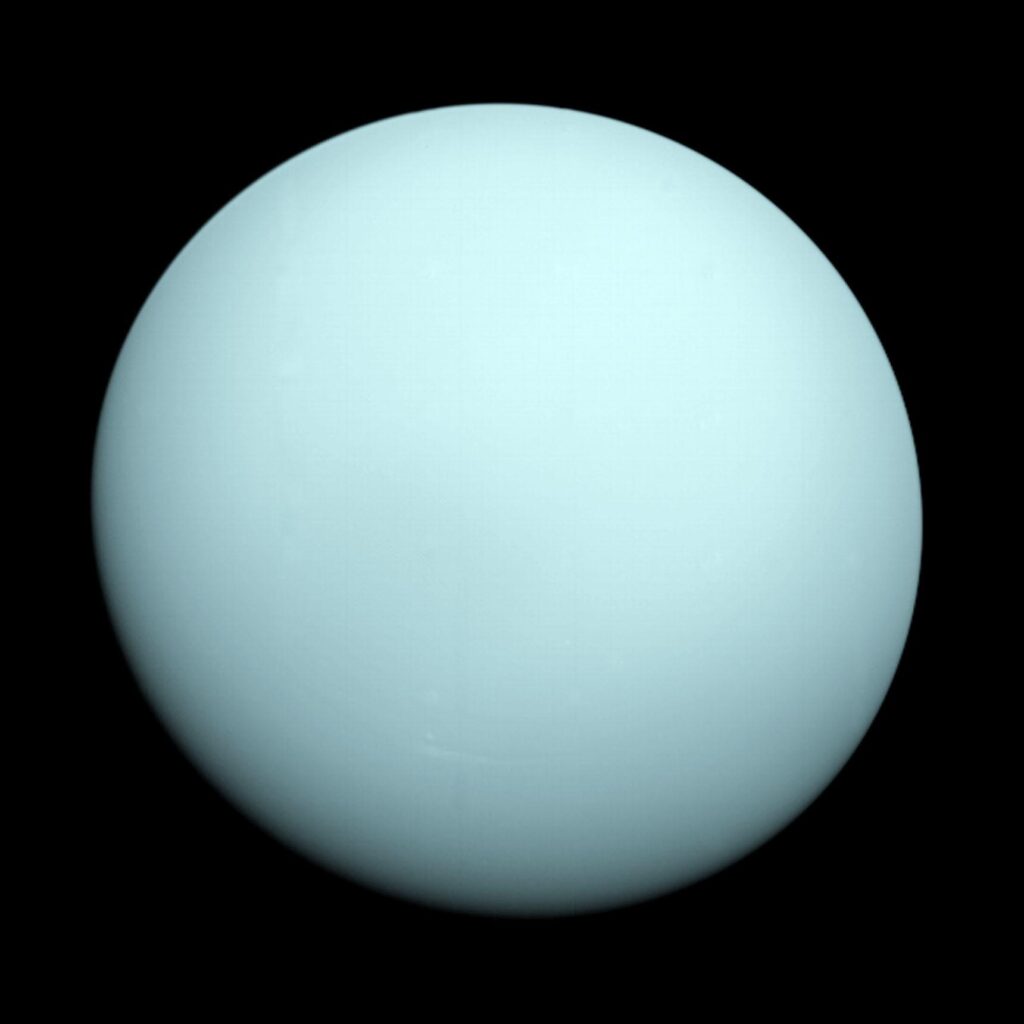
A Frigid World Beyond Expectations
Despite not being the farthest planet from the Sun, this ice giant holds the record for the coldest temperatures in the solar system. While Jupiter, Saturn, and Neptune all radiate more heat than they receive from the Sun, Uranus barely emits any excess warmth. Its atmosphere can plunge to a staggering -371°F (-224°C), making it even colder than Neptune. Scientists suspect that a violent collision during the planet’s early formation may have disrupted its internal structure, preventing it from generating and retaining heat. Without a strong internal heat source, its atmosphere cools rapidly, making it a unique case study among the outer planets and challenging traditional planetary models.
Because of this extreme cold, Uranus exhibits atmospheric behaviors unlike those seen on its gas giant counterparts. While Jupiter and Saturn have intense storms fueled by internal heat, this frigid planet relies solely on solar energy to drive its weather systems. The lack of heat flow from within may explain why its cloud layers appear relatively featureless compared to the turbulent atmospheres of other giant planets. However, some storms and high-altitude cloud activity have been detected, suggesting that unknown mechanisms still influence its climate. Understanding how such a cold planet maintains atmospheric motion remains a key question for future planetary research.

Credits: NASA, ESA, CSA, STScI. Image processing: J. DePasquale (STScI)
Unexpected Storms in a Frigid Atmosphere
Despite its reputation as a calm, featureless planet, this distant ice giant occasionally experiences intense and fast-moving storms. Observations from the Hubble Space Telescope have revealed massive cloud formations appearing primarily during the planet’s summer solstice. Scientists initially believed that such extreme cold would suppress atmospheric activity, yet storms similar to those on Neptune have been detected. The source of this unexpected turbulence remains unclear, as the planet lacks a strong internal heat source. Some researchers speculate that seasonal changes in solar radiation may trigger weather events, while others suggest that hidden heat sources deep within the atmosphere could be influencing these mysterious storms.
The storms on Uranus defy expectations because the planet receives minimal sunlight, making it unlikely that solar energy alone is responsible for their formation. Unlike Jupiter’s Great Red Spot, which has persisted for centuries, storms on this ice giant appear and disappear rapidly. Some cloud structures have been observed forming within hours, stretching across thousands of miles before dissipating just as quickly. High-altitude methane ice clouds, which reflect sunlight, contribute to sudden bright spots in the planet’s otherwise uniform appearance. Studying these unpredictable weather patterns remains a challenge, requiring further observations from both ground-based telescopes and future space missions
A Long-Awaited Mission to an Overlooked World
Despite being one of the largest planets in the solar system, this distant ice giant remains one of the least explored. Scientists have long called for a dedicated mission to uncover the secrets of its unique atmosphere, complex magnetic field, and mysterious moons. The proposed Uranus Orbiter and Probe (UOP) mission, expected to launch in the 2030s, could provide unprecedented data by sending both an orbiter and an atmospheric probe. This dual approach would allow scientists to study cloud layers, storm activity, and deep atmospheric composition while also mapping the planet’s magnetosphere in greater detail than the brief Voyager 2 flyby of 1986.
A major focus of future exploration involves searching for subsurface oceans on some of Uranus’ largest moons. Scientists suspect that icy worlds like Titania and Oberon may harbor liquid water beneath their frozen crusts, raising the possibility of habitable environments. A dedicated spacecraft could analyze the chemical composition of these moons, revealing whether conditions exist for microbial life. Additionally, studying the planet’s ring system and its unusual formation history could offer insights into planetary evolution beyond Earth. With growing technological advancements, a mission to this long-ignored ice giant could finally provide answers to decades-old scientific mysteries.

Credits: NASA, ESA, CSA, STScI. Image processing: J. DePasquale (STScI)
A Blueprint for Understanding Distant Worlds
Among the thousands of exoplanets discovered, many share characteristics with the solar system’s ice giants, making this distant planet an essential reference point. Most exoplanets identified so far are either gas giants like Jupiter or smaller rocky planets, but a significant number fall into the “sub-Neptune” category—planets similar in size and composition to Uranus. Studying its atmospheric composition, internal structure, and weather patterns can help scientists refine models of planetary formation. Understanding how this ice giant formed and evolved provides insights into the diverse planetary systems beyond our own, where distant worlds may have similar extreme climates, dynamic atmospheres, or even the potential for subsurface oceans.
The mysteries surrounding Uranus make it a key target for advancing exoplanetary research. Unlike gas giants that radiate significant heat, this planet emits very little, raising questions about the internal processes that shape its evolution. Future missions could help determine whether exoplanets of similar size also experience disrupted heat flow or unusual magnetic fields. Additionally, studying its rings and moons offers a comparative framework for understanding other planetary systems where similar features exist. As technology improves, the ice giant may become a cornerstone for decoding the atmospheres, climates, and potential habitability of planets orbiting distant stars.
How useful was this post?
Click on a star to rate it!
Average rating / 5. Vote count:
No votes so far! Be the first to rate this post.
Author
-
Meet Dr. Kendall Gregory, a highly accomplished professional with a remarkable academic background and a deep passion for empowering individuals through knowledge. Dr. Gregory’s educational journey began with a Bachelor of Science degree, followed by a Doctor of Chiropractic Medicine, focusing on diagnosing and treating musculoskeletal conditions. He further expanded his expertise with a Master's degree in Oriental Medicine, specializing in acupuncture and Chinese herbology, and a Master's degree in Health Care Administration, emphasizing his dedication to improving healthcare systems. Dr. Gregory combines his extensive knowledge and practical experience to provide comprehensive and integrative healthcare solutions. Through his writings, he aims to inspire individuals to take charge of their health and make informed decisions.
View all posts

